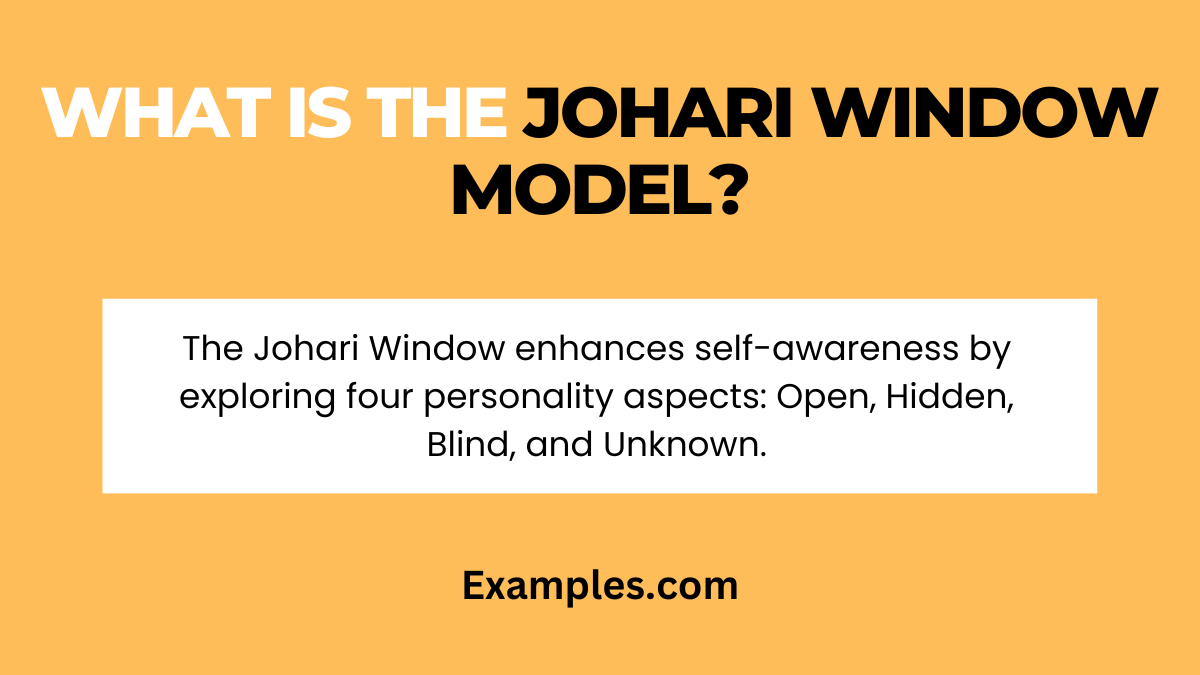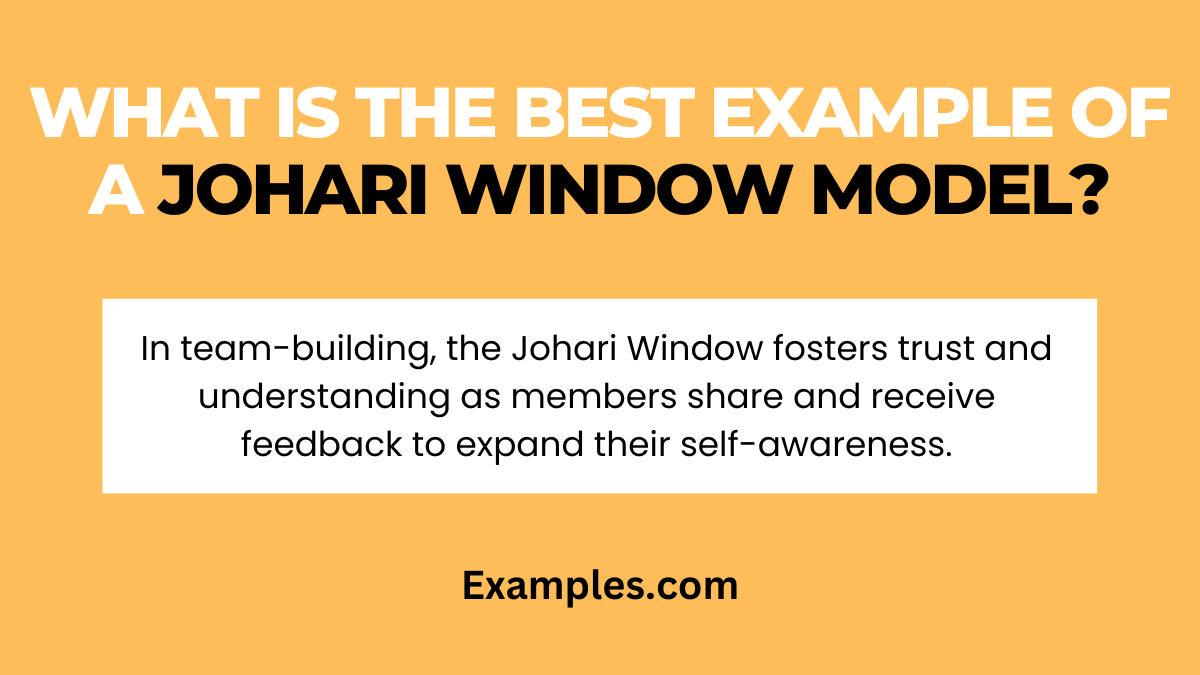19+ Johari Window Model Examples
The Johari Window Model is a transformative framework in the field of Intrapersonal Communication. This model, created by psychologists Joseph Luft and Harrington Ingham, is designed to enhance self-awareness and improve interpersonal relationships. It’s a tool that helps individuals understand their own behavior and communication style, as well as perceive how others view them. Utilizing the Johari Window Model can lead to more effective communication, better relationships, and personal growth.
What is the Johari Window Model?

The Johari Window Model is a psychological tool used in Intrapersonal Communication to help people better understand their relationship with themselves and others. It consists of four quadrants: Open, Hidden, Blind, and Unknown, each representing different parts of an individual’s personality. The model emphasizes the importance of self-disclosure and feedback in expanding the ‘Open’ area, leading to greater self-awareness and improved interpersonal dynamics.
History
Who Created: Luft and Ingham
Date: 1955
The Johari Window Model is a psychological tool for understanding self-awareness and interpersonal relationships through four distinct areas: Open, Hidden, Blind, and Unknown.
What is the Best Example of a Johari Window Model?

A practical example of the Johari Window Model is in team-building exercises. Here, team members are encouraged to share personal information (expanding the Open area) and receive feedback (reducing the Blind area). For instance, a team member might disclose a personal interest or fear, which others were not aware of, thereby increasing mutual understanding and trust within the team. This exercise demonstrates the model’s effectiveness in enhancing Intrapersonal Communication and collaboration.
20 Examples of Johari Window Model

The Johari Window Model is a transformative tool in Intrapersonal Communication, enhancing self-awareness and interpersonal relations. Here are 10 unique examples showcasing its application in various contexts, demonstrating the model’s versatility in revealing hidden aspects, soliciting feedback, and fostering open communication.
- Personal Development Workshop: Participants identify personal traits unknown to others, expanding the Open Area.
Example: “I am particularly passionate about environmental causes, something I haven’t shared before.” - Team Building Activity: Team members give and receive feedback, helping reduce the Blind Area.
Example: “You have a knack for problem-solving which you may not realize, but it greatly helps our team.” - Leadership Training: Leaders share their vulnerabilities, moving elements from Hidden to Open.
Example: “I find it challenging to balance assertiveness with empathy, an area I’m working on.” - Conflict Resolution Session: Exploring unknown factors in conflicts illuminates the Unknown Area.
Example: “Reflecting on our discussions, I now recognize my hesitation in confrontations stems from previous experiences.” - Peer Review Process: Colleagues provide feedback on observed strengths and weaknesses, lessening the Blind Area.
Example: “Your detailed reports are excellent, though engaging more with the team could enhance collaboration.” - Self-Reflection Exercise: Individuals uncover personal insights, shifting attributes from Hidden to Open.
Example: “I’ve realized I am more motivated in collaborative environments, a trait I hadn’t acknowledged until now.” - Counseling Session: Counselors help clients explore self-aspects in the Unknown Area.
Example: “Our conversations have revealed a pattern in your responses linked to your early experiences.” - Employee Onboarding: New employees express their expectations and apprehensions, contributing to the Open Area.
Example: “Starting this role excites me, but I also feel apprehensive about adapting to the new environment.” - Management Feedback Forum: Managers learn about unseen aspects of their leadership, addressing the Blind Area.
Example: “Feedback indicates a desire for more frequent and informal communication opportunities with management.” - Personal Goals Setting: Setting and sharing personal goals enlarges the Open Area.
Example: “My aim this year is to enhance my leadership skills, particularly in motivating my team.” - Professional Development Seminar: Professionals are encouraged to share career aspirations, moving these desires from Hidden to Open.
Example: “I aspire to transition into a leadership role within the next two years, a goal I’m now openly pursuing.” - Interpersonal Skills Workshop: Attendees discuss perceptions about themselves versus others’ views, addressing both Open and Blind areas.
Example: “I see myself as a good listener, but I’ve learned others sometimes find me too quiet in discussions.” - Family Therapy Session: Family members communicate feelings previously kept hidden, shifting them to the Open area.
Example: “I’ve often felt overlooked in family decisions, something I haven’t expressed until now.” - Cultural Sensitivity Training: Participants explore unknown biases, bringing them from the Unknown to the Blind or Open areas.
Example: “This training has made me aware of biases I didn’t realize I had, and I’m committed to addressing them.” - Feedback Session in Education: Teachers and students exchange feedback, reducing Blind spots for both parties.
Example: “Your teaching style is engaging, but more hands-on activities could enhance learning.” - Career Counseling: Counselors help clients uncover hidden talents or interests, moving them from Unknown to Open.
Example: “Our discussions have revealed your strong inclination towards creative writing, a path worth exploring.” - Workplace Diversity Program: Employees discuss experiences of inclusion, or lack thereof, making the workplace environment more Open.
Example: “Sharing my experiences as a minority in the company has opened up conversations about diversity and inclusion.” - Self-Assessment Exercise in a Corporate Setting: Employees evaluate their skills and limitations, moving insights from Hidden to Open.
Example: “Self-assessment has made me realize my potential in strategic planning, an area I’d like to develop further.” - Community Engagement Project: Community members voice concerns and aspirations, shifting local issues from Hidden to Open.
Example: “As a community, we need more recreational spaces for our youth, a concern we’ve not addressed before.” - Performance Review Meeting: Managers and employees discuss performance openly, addressing both Open and Blind areas.
Example: “Your report accuracy is outstanding, though taking on more leadership roles could further your career development.”
Elements of Johari Window Model
The Johari Window Model, a key framework in Intrapersonal Communication, comprises four main elements or quadrants, each representing different aspects of an individual’s awareness:
- Open Area: Known to oneself and others; includes traits, skills, and experiences openly communicated.
- Blind Area: Known to others but unknown to oneself; may include blind spots in personality or behavior.
- Hidden Area: Known to oneself but hidden from others; contains feelings, fears, and private information.
- Unknown Area: Unknown to both oneself and others; could include undiscovered talents or unconscious motives.
Each of these elements plays a significant role in how individuals communicate with themselves and others, impacting personal growth and relationships.
What is the Johari Window Diagram
The Johari Window Diagram is a simple representation of the Johari Window Model, usually depicted as a square divided into four equal quadrants. Each quadrant represents a different area of self-awareness according to the model:
- Open Area (top left quadrant): Known to oneself and known to others. This area represents traits, behaviors, and knowledge that are open and known to both the individual and people around them.
- Blind Area (top right quadrant): Unknown to oneself but known to others. This includes aspects that others see in an individual but the individual may not recognize in themselves.
- Hidden Area (bottom left quadrant): Known to oneself but unknown to others. This area contains information, feelings, and experiences that an individual is aware of but chooses not to reveal to others.
- Unknown Area (bottom right quadrant): Unknown to oneself and unknown to others. This quadrant represents traits and potential that neither the individual nor others are aware of.
The diagram is typically used in personal development workshops and group sessions to help participants understand different aspects of themselves and improve communication with others. It serves as a visual tool to facilitate discussion and self-discovery.
Goals of Johari Window Model
The Johari Window Model aims to enhance Intrapersonal Communication and self-awareness, with several specific goals:
- Increase Self-Awareness: To help individuals understand more about themselves, including hidden talents and blind spots.
- Enhance Personal Development: To facilitate personal growth and improvement in communication skills.
- Improve Relationships: To foster better understanding and communication within relationships.
- Encourage Openness: To motivate individuals to share more about themselves, increasing the Open Area.
- Reduce Misunderstandings: To minimize conflicts and misunderstandings by clarifying perceptions.
- Enhance Team Dynamics: To build stronger, more cohesive teams through mutual understanding.
- Facilitate Feedback Reception: To make individuals more receptive to feedback, reducing the Blind Area.
- Promote Discovery: To uncover hidden potential and unknown aspects of one’s personality.
The Johari Window Model serves as a comprehensive approach to personal and interpersonal development.
How does the Johari Window Model Work?
The Johari Window Model functions as a dynamic framework in Intrapersonal Communication, operating through several mechanisms:
- Self-Disclosure: Individuals share personal information, increasing the Open Area.
- Feedback Solicitation: Asking for feedback from others to reduce the Blind Area.
- Self-Discovery: Engaging in introspection and activities to uncover the Hidden Area.
- Interaction and Experience: Through interactions and experiences, parts of the Unknown Area become known.
- Adaptability: The model adapts as individuals receive feedback and disclose information.
- Reflective Practice: Encourages reflective thinking to understand and interpret feedback.
- Communication Enhancement: Improves communication by aligning self-perception with others’ perceptions.
- Continuous Process: It’s a continual process of learning and adapting, expanding the Open Area over time.
The Johari Window Model is an invaluable tool in Intrapersonal Communication, offering profound insights into self-awareness and interpersonal relationships. This guide has explored its elements, goals, and functionality, providing a comprehensive understanding of its application. Embracing this model can lead to enhanced personal growth, improved communication skills, and stronger relationships, making it a fundamental component for anyone seeking to deepen their understanding of self and others.



